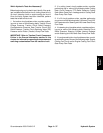
Groundsmaster 4000--D/4010--D Hydraulic SystemPage 4 -- 39
ProcedureforTractionCircuit Charge PressureTest
1. Make sure hydraulic oil is at normal operating tem-
perature by operating the machine under load for
approximately ten (10) minutes. Make sure the hydrau-
lic tank is full.
2. Park machine on a level surface with the cutting
decks lowered and off. Make sure engine is off and the
parking brake is applied.
3. Raise and support operator seat.
CAUTION
Prevent personal injury and/or damage to equip-
ment. Read all WARNINGS, CAUTIONS and Pre-
cautions for Hydraulic Testing at the beginning
of this section.
4. Connect a 1000 PSI (70 bar) pressure gauge onto
charge pressure test port on filter manifold (Fig. 26).
5. Start the engine and put throttle at high idle speed
(2870 RPM) with no load on the hydraulic system.
GAUGEREADINGTOBE200 to 300 PSI (13.8 to
20.6 bar).
6. Stop engine and record test results.
7. If there is no pressure or pressure is low, check for
restrictioninpumpintake line. Also, inspect chargerelief
valve located in filter manifold (see Filter Manifold Ser-
vice in the Service and Repairs section of this chapter).
A worn or damaged gear pump (P3) could also be con-
sidered (see Steering and Lift/Lower Gear Pump Flow
Test in this section).
NOTE: If gear pump (P3) is worn or damaged, charge,
steering and lift circuits will all be affected.
8. Next, with the pressure gauge still connected to the
charge pressure test port, take a gauge reading while
operating the machine in forward and reverse. Start the
engine and put throttle at high idle speed (2870 RPM).
Apply the brakes and push the traction pedal forward
while monitoring the pressure gauge. Repeat for re-
verse direction. Stop engine and record test results.
9. If charge pressure meets specifications under no
load conditions (step 5 above), but consistently drops
more than 15% when under traction load, the piston
(traction) pump and/or traction motor(s) should be sus-
pected of wear and inefficiency. When the pump or mo-
tors are worn or damaged, the charge pump is not able
to keep up with internal leakage in the traction system
components.
10.When testing is completed, disconnect pressure
gauge from test port. Lower and secure operator ’s seat.
1. Charge pressure port 2. Filter manifold
Figure 26
1
2
Hydraulic
System


















